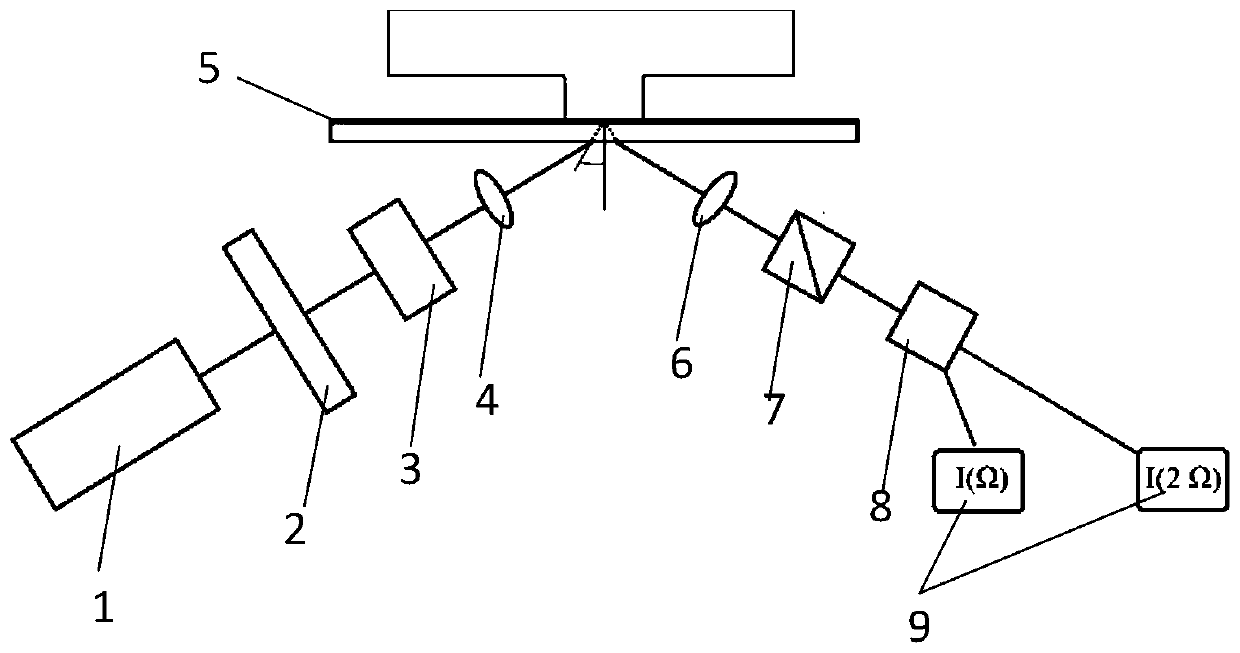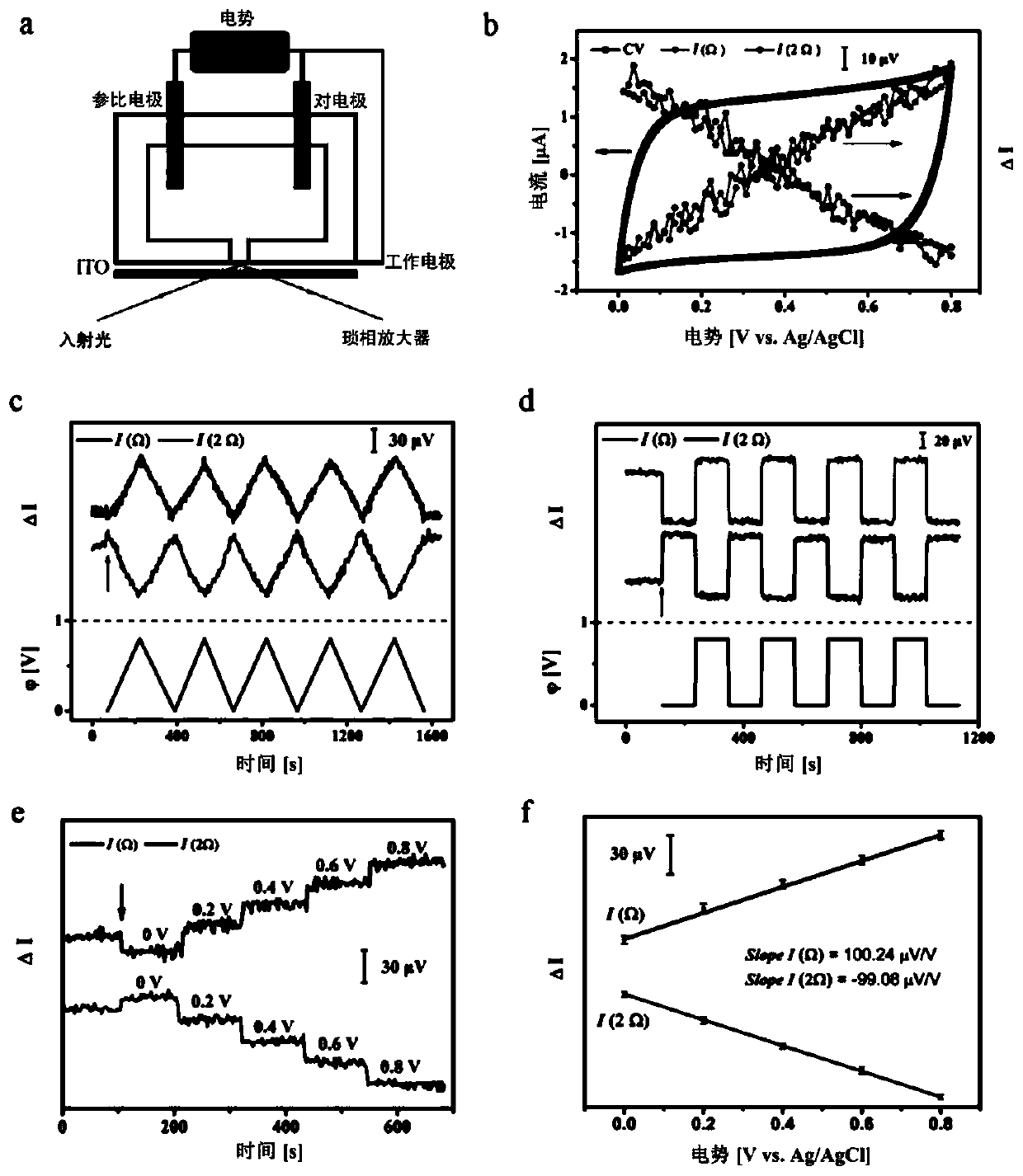Transparent electrode potential real-time monitoring device and method based on oblique incident light reflection difference method
A real-time monitoring, electrode potential technology, applied in the direction of measurement device, polarization influence characteristics, material electrochemical variables, etc., can solve the problems of inaccurate monitoring, electrode damage, electrical measurement method relying on electronic connection, etc., to achieve the effect of accurate monitoring
- Summary
- Abstract
- Description
- Claims
- Application Information
AI Technical Summary
Problems solved by technology
Method used
Image
Examples
Embodiment 1
[0043] Oblique incident light reflectance difference method (OIRD) is a new method developed in the past two decades to detect interface changes without marking, without damage, and in real time. By measuring the two polarized light components of the reflected light obliquely incident on the interface Changes in the difference between (s and p) are used to detect changes in interface characteristics. Subtle changes in dielectric constant or scale in space and time caused by composition changes and structural changes on the interface can cause incident light s and Different changes in the reflectivity of the p-component to obtain the OIRD signal.
[0044] Such as figure 1 As shown, in which, 1 in the figure represents the laser, 2 represents the photoelastic modulator PEM, 3 represents the phase shifter PS, 4 represents the incident lens L1, 5 represents the transparent electrode, 6 represents the exit lens L2, and 7 represents the polarization analyzer , 8 represents the phot...
Embodiment 2
[0083] The method for real-time monitoring of the transparent electrode potential based on the oblique incident light reflection difference method provided in this embodiment includes the following steps:
[0084] The laser emits a beam of elliptically polarized light;
[0085] The polarized light passes through the phase shifter after being modulated by the photoelastic modulator;
[0086] The light emitted from the phase shifter is focused by the incident lens and obliquely incident on the surface of the transparent electrode according to the preset incident angle;
[0087] The laser light reflected from the electrode surface enters the polarization analyzer after passing through the exit lens;
[0088] The light emitted from the polarization analyzer is converted into a voltage signal through a photodiode;
[0089] The fundamental frequency component signal and the multiplier frequency component signal of the modulation frequency in the voltage signal are collected by two...
Embodiment 3
[0095] Such as figure 22a) shows the scheme of the OIRD setup for monitoring potential changes in a three-electrode system; 2b) ITO-1 electrode in 3M KCl solution at a scan rate of 5mV s-1 from 0V to 0.8V The CV curve and the simultaneous OIRD signal were recorded above; the OIRD signal was recorded simultaneously; 2c) at a scan rate of 5 mV s-1 during 5 consecutive potential cycles from 0 to 0.8V; 2d) the potential from 0 to 0.8V Steps; 2e) Potentials were stepped from 0 to 0.8 V at 0.2 V intervals; 2f) The average OIRD signal for each potential was plotted against the applied potential in 2e) and the corresponding linear fit line.
[0096] The three-electrode system provided in this embodiment is provided with a scanning system for real-time adjustment of the driving voltage of the electrodes.
[0097] What this embodiment provides is to monitor the potential change of the ITO electrode surface in real time, and the specific process is as follows:
[0098] Under the tradi...
PUM
| Property | Measurement | Unit |
|---|---|---|
| Wavelength | aaaaa | aaaaa |
| Thickness | aaaaa | aaaaa |
| Thickness | aaaaa | aaaaa |
Abstract
Description
Claims
Application Information
 Login to View More
Login to View More - R&D
- Intellectual Property
- Life Sciences
- Materials
- Tech Scout
- Unparalleled Data Quality
- Higher Quality Content
- 60% Fewer Hallucinations
Browse by: Latest US Patents, China's latest patents, Technical Efficacy Thesaurus, Application Domain, Technology Topic, Popular Technical Reports.
© 2025 PatSnap. All rights reserved.Legal|Privacy policy|Modern Slavery Act Transparency Statement|Sitemap|About US| Contact US: help@patsnap.com



